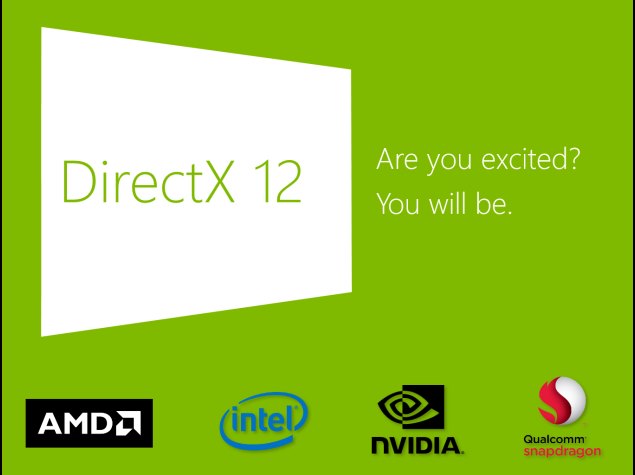- Home
- Laptops
- Laptops News
- GDC: Microsoft announces DirectX 12 for richer PC, console, and mobile graphics
GDC: Microsoft announces DirectX 12 for richer PC, console, and mobile graphics

Microsoft has taken the wraps off DirectX 12, the latest version of its set of APIs for gaming and multimedia applications. DirectX allows hardware and software to interoperate, creating a standard platform for game developers to build on across hardware from various brands. DirectX 12 is designed to improve performance scaling for modern hardware, and reduce processing overhead by allowing software developers to access more hardware features than before. Other significant improvements include a reduction in CPU usage of up to 50 percent, and better distribution of work between CPU cores.
DirectX 12 is currently in an alpha state, and Microsoft is targeting a winter 2015 release, to line up with games released in the busy holiday season. The demonstration at the ongoing Game Developers' Conference in San Francisco was focused on Direct3D, the primary graphics component of DirectX.
Microsoft has reaffirmed support for Direct3D across all its platforms: Windows, Xbox, Windows Phone and even Windows RT. The most significant improvement is its ability to address different hardware architectures while offering developers a standardized platform with minimal translation overheads. Specific improvements include performance gains in transparency effects, collision detection, and geometry overlap detection.
Microsoft listed AMD, Intel, Nvidia and Qualcomm as major supporting partners at its GDC panel, titled DirectX: Evolving Microsoft's Graphics Platform. The inclusion of Qualcomm illustrates the growing importance of mobile platforms. AMD also supports DirectX on all its graphics hardware, but its own recently announced Mantle APIs provide much the same functionality that was outlined for DX12, with regard to low-level access to hardware features.
DirectX 12 will be supported on current DirectX 11 hardware, which Microsoft says accounts for up to 80 percent of gaming PCs shipping today. Nvidia will roll out support for all its Fermi, Kepler and Maxwell cards, which should include cards going back to the 2010-era GeForce 400 series. AMD indicated that its Graphics Core Next (GCN) cards onwards would be supported, which would include only some products in the Radeon HD 7000, R7 and R9 series. For mobile devices, the key promise is lower power consumption, thanks to a reduction in processing overheads.
On the software side, Windows 8 and 8.1 are supported, but Microsoft declined to comment on support for Windows 7. The Xbox One will also be able to take advantage of various improvements related to performance and power consumption.
For the latest tech news and reviews, follow Gadgets 360 on X, Facebook, WhatsApp, Threads and Google News. For the latest videos on gadgets and tech, subscribe to our YouTube channel. If you want to know everything about top influencers, follow our in-house Who'sThat360 on Instagram and YouTube.
Related Stories
- Amazon Great Indian Festival 2024
- Big Billion Days 2024
- Apple Vision Pro
- Oneplus 12
- iPhone 14
- Apple iPhone 15
- OnePlus Nord CE 3 Lite 5G
- iPhone 13
- Xiaomi 14 Pro
- Oppo Find N3
- Tecno Spark Go (2023)
- Realme V30
- Best Phones Under 25000
- Samsung Galaxy S24 Series
- Cryptocurrency
- iQoo 12
- Samsung Galaxy S24 Ultra
- Giottus
- Samsung Galaxy Z Flip 5
- Apple 'Scary Fast'
- Housefull 5
- GoPro Hero 12 Black Review
- Invincible Season 2
- JioGlass
- HD Ready TV
- Laptop Under 50000
- Smartwatch Under 10000
- Latest Mobile Phones
- Compare Phones
- Vivo Y300 5G
- Red Magic 10 Pro+
- Red Magic 10 Pro
- Asus ROG Phone 9
- Asus ROG Phone 9 Pro
- ZTE Blade V70
- Vivo Y18t
- Honor X9c
- Asus Zenbook S 14
- MacBook Pro 16-inch (M4 Max, 2024)
- Huawei MatePad 11.5
- Acer Iconia Tab 10.36 (iM10-22)
- Redmi Band 3
- Xiaomi Smart Band 9 Pro
- Sony 65 Inches Ultra HD (4K) LED Smart TV (KD-65X74L)
- TCL 55 Inches Ultra HD (4K) LED Smart TV (55C61B)
- Sony PlayStation 5 Pro
- Sony PlayStation 5 Slim Digital Edition
- Carrier 2.0 Ton 5 Star Inverter Split AC (24K EMPERIA LXI INV)
- Lloyd 2 Ton 3 Star Inverter Split AC (GLS24I36WGVR)















